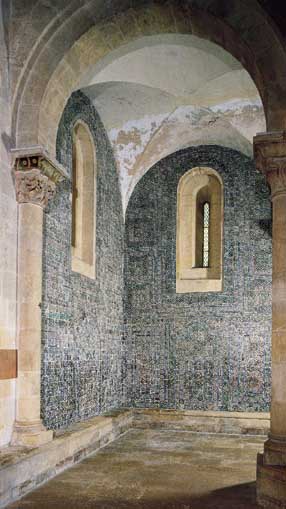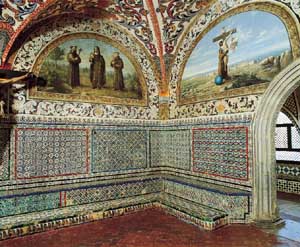|
|
|
|
|
|
|
|
|
|
|
 |
|
|
|
|
|
|
|
|
|
|
|
|
 |
|
The XV and XVI Centuries
The Islamic tradition
|
 he first known Portuguese examples of the use of AZULEJOS as a monumental wall-covering employed Hispano-Moorish tiles which were imported from Seville in around 1503. he first known Portuguese examples of the use of AZULEJOS as a monumental wall-covering employed Hispano-Moorish tiles which were imported from Seville in around 1503.
One of the lasting consequences of the Arab presence in the Iberian Peninsula was the continued practise of tile making. Seville was the great centre of the tile industry, which continued to employ the archaic "cuerda seca" and "cuenca" techniques until the mid XVI century.
 The motifs on the tiles evolved from geometric Moorish lace-like and looping designs into European plant and animal themes which gradually progressed from the Gothic to the pure Renaissance style. The motifs on the tiles evolved from geometric Moorish lace-like and looping designs into European plant and animal themes which gradually progressed from the Gothic to the pure Renaissance style.
Nevertheless, quite apart from the motifs themselves, Portugal retained a Moorish taste for excess in the practise of completely covering surfaces with decorations - a kind of rejection of emptiness.
|
Coimbra Cathedral,
early XVI century.
photograph: Paulo Cintra
and Laura Castro Caldas
|
|
|
|
|
|
Armillary sphere,
Sintra National Palace,
c. 1500.
photograph: Nicolas Lemonnier
|
|
|
|
|
|
 |
|
|
The frontispiece of an altar,
Sintra National Palace,
c. 1500
photograph: Nicolas Lemonnier
|
|
|
|
|
|
 |
|
|
|
|
|
|
|
Conceição Convent,
The Chapter Room, Beja,
1st quarter
of the XVI century.
photograph: Paulo Cintra
and Laura Castro Caldas
|
|
|
|
|
|
|
|
© Instituto Camões, 2000
|
|